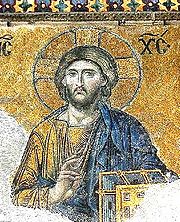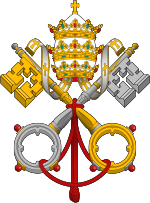Stations of the Cross
Stations of the Cross (or Way of the Cross; in Latin, Via Crucis; also called the Via Dolorosa or Way of Sorrows, or simply, The Way) refers to the depiction of the final hours (or Passion) of Jesus, and the devotion commemorating the Passion. The tradition as chapel devotion began with St. Francis of Assisi and extended throughout the Roman Catholic Church in the medieval period. It is less often observed in the Anglican and Lutheran churches. It may be done at any time, but is most commonly done during the Season of Lent, especially on Good Friday and on Friday evenings during Lent.
Contents |
History
The Stations of the Cross originated in pilgrimages to Jerusalem. A desire to reproduce the holy places in other lands seems to have manifested itself at quite an early date. At the monastery of San Stefano at Bologna a group of connected chapels was constructed as early as the 5th century, by St. Petronius, Bishop of Bologna, which was intended to represent the more important shrines of Jerusalem, and in consequence, this monastery became familiarly known as "Hierusalem.” These may perhaps be regarded as the germ from which the Stations afterwards developed, though it is tolerably certain that nothing that we have before about the 15th century can strictly be called a Way of the Cross in the modern sense. Although several travelers who visited the Holy Land during the twelfth, thirteenth, and 14th centuries, mention a "Via Sacra,” i.e., a settled route along which pilgrims were conducted, there is nothing in their accounts to identify this with the Way of the Cross, as we understand it. The devotion of the Via Dolorosa, for which there have been a number of variant routes in Jerusalem, was probably developed by the Franciscans after they were granted administration of the Christian holy places in Jerusalem in 1342.
The earliest use of the word “stations,” as applied to the accustomed halting-places in the Via Sacra at Jerusalem, occurs in the narrative of an English pilgrim, William Wey, who visited the Holy Land in the mid-15th century, and described pilgrims following the footsteps of Christ to the cross.
During the fifteenth and 16th centuries the Franciscans began to build a series of outdoor shrines in Europe to duplicate their counterparts in the Holy Land. The number of stations varied between eleven and thirty. In 1686, in answer to their petition, Pope Innocent XI granted to the Franciscans the right to erect stations within their churches. In 1731, Pope Clement XII extended the right of all churches to have the stations, provided that a Franciscan father erected them, with the consent of the local bishop. At the same time the number was fixed at fourteen. In 1857, the bishops of England were allowed to erect the stations by themselves, without the intervention of a Franciscan priest, and in 1862 this right was extended to bishops throughout the church.[1]
Spiritual Significance
The object of the Stations is to help the faithful to make a spiritual pilgrimage of prayer, through meditating upon the chief scenes of Christ's sufferings and death. It has become one of the most popular devotions for Roman Catholics, as well as featuring in the worship and devotion of other Christian denominations.
Catholic Reparations

Cathedral of Santiago de Compostela, Spain.
In the Roman Catholic tradition, the meditation is often performed in a spirit of reparation for the sufferings and insults that Jesus endured during His Passion.[2]
In his encyclical letter, Miserentissimus Redemptor, on reparations, Pope Pius XI called Acts of Reparation to Jesus Christ a duty for Catholics and referred to them as "some sort of compensation to be rendered for the injury" with respect to the sufferings of Jesus.[3]
Pope John Paul II referred to Acts of Reparation as the "unceasing effort to stand beside the endless crosses on which the Son of God continues to be crucified".[4]
The Stations
Traditional Form

The Stations themselves are usually a series of 14 pictures or sculptures depicting the following scenes:
- Jesus is condemned to death
- Jesus is given his cross
- Jesus falls the first time
- Jesus meets His Mother
- Simon of Cyrene carries the cross
- Veronica wipes the face of Jesus
- Jesus falls the second time
- Jesus meets the daughters of Jerusalem
- Jesus falls the third time
- Jesus is stripped of His garments
- Crucifixion: Jesus is nailed to the cross
- Jesus dies on the cross
- Jesus' body is removed from the cross (Deposition or Lamentation)
- Jesus is laid in the tomb and covered in incense.
Although not traditionally part of the Stations, the Resurrection of Jesus is sometimes included as a fifteenth station.[5][6]
Scriptural Way of the Cross
|
Part of a series of articles on |
|---|
|
Overview of Devotions Prayers to Jesus |
Out of the fourteen traditional Stations of the Cross, only eight have clear scriptural foundation. Stations 3, 4, 6, 7, and 9 are not specifically attested to in the gospels and Station 13 (representing Jesus's body being taken down off the cross and laid in the arms of his mother Mary) seems to embellish the gospels' record, which states that Joseph of Arimathea took Jesus down from the cross and buried him. To provide a version of this devotion more closely aligned with the biblical accounts, Pope John Paul II introduced a new form of devotion, called the Scriptural Way of the Cross on Good Friday 1991. He celebrated that form many times but not exclusively at the Colosseum in Rome.[7][8] In 2007, Pope Benedict XVI approved this set of stations for meditation and public celebration: They follow this sequence:
- Jesus in the Garden of Gethsemane,
- Jesus is betrayed by Judas and arrested,
- Jesus is condemned by the Sanhedrin,
- Jesus is denied by Peter,
- Jesus is judged by Pilate,
- Jesus is scourged and crowned with thorns,
- Jesus takes up His cross,
- Jesus is helped by Simon to carry His cross,
- Jesus meets the women of Jerusalem,
- Jesus is crucified,
- Jesus promises His kingdom to the repentant thief,
- Jesus entrusts Mary and John to each other,
- Jesus dies on the cross,
- Jesus is laid in the tomb.
Modern Usage
_01.jpg)
The devotion may be conducted personally by the faithful, making their way from one station to another and saying the prayers, or by having an officiating celebrant move from cross to cross while the faithful make the responses. The stations themselves must consist of, at the very least, fourteen wooden crosses, pictures alone do not suffice, and they must be blessed by someone with the authority to erect stations.
In the Roman Catholic Church, Pope John Paul II led an annual public prayer of the Stations of the Cross at the Roman Colosseum on Good Friday. Originally, the Pope himself carried the cross from station to station, but in his last years when age and infirmity limited his strength, John Paul presided over the celebration from a stage on the Palatine Hill, while others carried the cross. Just days prior to his death in 2005, Pope John Paul II observed the Stations of the Cross from his private chapel. Each year a different person is invited to write the meditation texts for the Stations. Past composers of the Papal Stations include several non-Catholics. The Pope himself wrote the texts for the Great Jubilee in 2000 and used the traditional Stations.
The celebration of the Stations of the Cross is especially common on the Fridays of Lent, especially Good Friday. Community celebrations are usually accompanied by various songs and prayers. Particularly common as musical accompaniment is the Stabat Mater. At the end of each station the Adoramus Te is sometimes sung. The Alleluia is also sung, except during Lent.
Structurally, Mel Gibson's 2004 film, The Passion of the Christ, follows the Stations of the Cross. The fourteenth and last station, the Burial, is not prominently depicted (compared to the other thirteen) but it is implied since the last shot before credit titles is Jesus resurrected and about to leave the tomb.
Debates Regarding the Stations of the Cross
The Place of the Resurrection in the Stations
Some modern liturgists[9] say the traditional Stations of the Cross are incomplete without a final scene depicting the empty tomb and/or the resurrection of Jesus, because Jesus' rising from the dead was an integral part of his salvific work on earth.
Advocates of the traditional form of the Stations ending with the body of Jesus being placed in the tomb say the Stations are intended as a meditation on the atoning death of Jesus, and not as a complete picture of his life, death, and resurrection.
The Stations of the Resurrection (also known by the Latin name of Via Lucis) are used in some churches at Eastertide to meditate on the Resurrection and Ascension of Jesus Christ.
The Ukrainian Byzantine Catholic Church
As part of a process of de-Latinization, the Ukrainian Byzantine Catholic Church eliminated the devotion of the Stations of the Cross. In response to this, a schismatic group called the Society of Saint Josaphat (SSJK) has formed with a seminary of its own in Lviv with thirty students at present.
Gallery
Other pictures related to the stations of the cross
 Stations in Church of St. Casimir the Prince |
 From The Cloisters in New York City. |
Station in Upper Swabia, Germany |
|
 Elaborate 19th century stations I and II, Sacré-Coeur Paris |
 Tomb of Jesus |
 14th Station in Franciscan Monastery in Woźniki, Poland |
See also
- Acts of Reparation to Jesus Christ
- Passion play
- Poor Man's Bible
- Sacri Monti of Piedmont and Lombardy
- Prayer Labyrinth
References
- ↑ The Catholic Encyclopedia (1907)s.v. "The Way of the Cross."
- ↑ Ann Ball, 2003 Encyclopedia of Catholic Devotions and Practices ISBN 087973910X
- ↑ Miserentissimus Redemptor, Encyclical of Pope Pius XI
- ↑ Pope John Paul II, Letter to Cardinal Fiorenzo Angelini, for the 50th anniversary of the Benedictine Sisters of Reparation of the Holy Face, 27 September 2000 (Vatican archives)
- ↑ "The Official Web Site for the Archdiocese of Detroit". http://www.aodonline.org/AODOnline/Prayers+and+Reflection+12179/Stations+of+the+Cross+2309/Stations+of+the+Resurrection+-+Via+Lucis.htm. Retrieved 2009-04-04. "In some contemporary Stations of the Cross, a fifteenth station has been added to commemorate the Resurrection of the Lord."
- ↑ "Fr. William Saunders". http://www.ewtn.com/library/ANSWERS/STCROSS.HTM. Retrieved 2009-04-04. "Because of the intrinsic relationship between the passion and death of our Lord with His resurrection, several of the devotional booklets now include a 15th station, which commemorates the Resurrection."
- ↑ Joseph M Champlin, The Stations of the Cross With Pope John Paul II Liguori Publications, 1994, ISBN 0892436794
- ↑ Pope John Paul II, Meditation and Prayers for the Stations of the Cross at the Colosseum, Good Friday, 2000
- ↑ McBrien, Richard P.; Harold W. Attridge (1995). The HarperCollins encyclopedia of Catholicism. p. 1222. ISBN 9780060653385.
External links
- 14 black and white watercolors in a multilingual Way of the Cross
- "Way of the Cross" article from The Catholic Encyclopedia
- A list of recent Via Crucis used by The Vatican on Good Fridays..
- Esquivel's (Nobel Peace Prize) Stations from Latin America
- Alternate Stations of the Cross as celebrated by Pope John Paul II on Good Friday 1991
|
|||||||||||||||||||||

